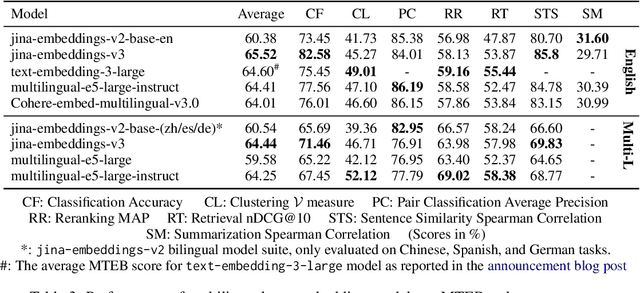Georgios Mastrapas
jina-clip-v2: Multilingual Multimodal Embeddings for Text and Images
Dec 11, 2024



Abstract:Contrastive Language-Image Pretraining (CLIP) is a highly effective method for aligning images and texts in a shared embedding space. These models are widely used for tasks such as cross-modal information retrieval and multi-modal understanding. However, CLIP models often struggle with text-only tasks, underperforming compared to specialized text models. This performance disparity forces retrieval systems to rely on separate models for text-only and multi-modal tasks. In this work, we build upon our previous model, jina-clip-v1, by introducing a refined framework that utilizes multi-task, multi-stage contrastive learning across multiple languages, coupled with an improved training recipe to enhance text-only retrieval. The resulting model, jina-clip-v2, outperforms its predecessor on text-only and multimodal tasks, while adding multilingual support, better understanding of complex visual documents and efficiency gains thanks to Matryoshka Representation Learning and vector truncation. The model performs comparably to the state-of-the-art in both multilingual-multimodal and multilingual text retrieval benchmarks, addressing the challenge of unifying text-only and multi-modal retrieval systems.
jina-embeddings-v3: Multilingual Embeddings With Task LoRA
Sep 17, 2024



Abstract:We introduce jina-embeddings-v3, a novel text embedding model with 570 million parameters, achieves state-of-the-art performance on multilingual data and long-context retrieval tasks, supporting context lengths of up to 8192 tokens. The model includes a set of task-specific Low-Rank Adaptation (LoRA) adapters to generate high-quality embeddings for query-document retrieval, clustering, classification, and text matching. Additionally, Matryoshka Representation Learning is integrated into the training process, allowing flexible truncation of embedding dimensions without compromising performance. Evaluation on the MTEB benchmark shows that jina-embeddings-v3 outperforms the latest proprietary embeddings from OpenAI and Cohere on English tasks, while achieving superior performance compared to multilingual-e5-large-instruct across all multilingual tasks.
Jina-ColBERT-v2: A General-Purpose Multilingual Late Interaction Retriever
Sep 04, 2024



Abstract:Multi-vector dense models, such as ColBERT, have proven highly effective in information retrieval. ColBERT's late interaction scoring approximates the joint query-document attention seen in cross-encoders while maintaining inference efficiency closer to traditional dense retrieval models, thanks to its bi-encoder architecture and recent optimizations in indexing and search. In this paper, we introduce a novel architecture and a training framework to support long context window and multilingual retrieval. Our new model, Jina-ColBERT-v2, demonstrates strong performance across a range of English and multilingual retrieval tasks,
Jina CLIP: Your CLIP Model Is Also Your Text Retriever
May 30, 2024



Abstract:Contrastive Language-Image Pretraining (CLIP) is widely used to train models to align images and texts in a common embedding space by mapping them to fixed-sized vectors. These models are key to multimodal information retrieval and related tasks. However, CLIP models generally underperform in text-only tasks compared to specialized text models. This creates inefficiencies for information retrieval systems that keep separate embeddings and models for text-only and multimodal tasks. We propose a novel, multi-task contrastive training method to address this issue, which we use to train the jina-clip-v1 model to achieve the state-of-the-art performance on both text-image and text-text retrieval tasks.
Multi-Task Contrastive Learning for 8192-Token Bilingual Text Embeddings
Feb 26, 2024



Abstract:We introduce a novel suite of state-of-the-art bilingual text embedding models that are designed to support English and another target language. These models are capable of processing lengthy text inputs with up to 8192 tokens, making them highly versatile for a range of natural language processing tasks such as text retrieval, clustering, and semantic textual similarity (STS) calculations. By focusing on bilingual models and introducing a unique multi-task learning objective, we have significantly improved the model performance on STS tasks, which outperforms the capabilities of existing multilingual models in both target language understanding and cross-lingual evaluation tasks. Moreover, our bilingual models are more efficient, requiring fewer parameters and less memory due to their smaller vocabulary needs. Furthermore, we have expanded the Massive Text Embedding Benchmark (MTEB) to include benchmarks for German and Spanish embedding models. This integration aims to stimulate further research and advancement in text embedding technologies for these languages.
Jina Embeddings 2: 8192-Token General-Purpose Text Embeddings for Long Documents
Oct 30, 2023Abstract:Text embedding models have emerged as powerful tools for transforming sentences into fixed-sized feature vectors that encapsulate semantic information. While these models are essential for tasks like information retrieval, semantic clustering, and text re-ranking, most existing open-source models, especially those built on architectures like BERT, struggle to represent lengthy documents and often resort to truncation. One common approach to mitigate this challenge involves splitting documents into smaller paragraphs for embedding. However, this strategy results in a much larger set of vectors, consequently leading to increased memory consumption and computationally intensive vector searches with elevated latency. To address these challenges, we introduce Jina Embeddings 2, an open-source text embedding model capable of accommodating up to 8192 tokens. This model is designed to transcend the conventional 512-token limit and adeptly process long documents. Jina Embeddings 2 not only achieves state-of-the-art performance on a range of embedding-related tasks in the MTEB benchmark but also matches the performance of OpenAI's proprietary ada-002 model. Additionally, our experiments indicate that an extended context can enhance performance in tasks such as NarrativeQA.
Jina Embeddings: A Novel Set of High-Performance Sentence Embedding Models
Aug 01, 2023Abstract:Jina Embeddings constitutes a set of high-performance sentence embedding models adept at translating various textual inputs into numerical representations, thereby capturing the semantic essence of the text. The models excel in applications such as dense retrieval and semantic textual similarity. This paper details the development of Jina Embeddings, starting with the creation of high-quality pairwise and triplet datasets. It underlines the crucial role of data cleaning in dataset preparation, gives in-depth insights into the model training process, and concludes with a comprehensive performance evaluation using the Massive Textual Embedding Benchmark (MTEB). To increase the model's awareness of negations, we constructed a novel training and evaluation dataset of negated and non-negated statements, which we make publicly available to the community.
 Add to Chrome
Add to Chrome Add to Firefox
Add to Firefox Add to Edge
Add to Edge